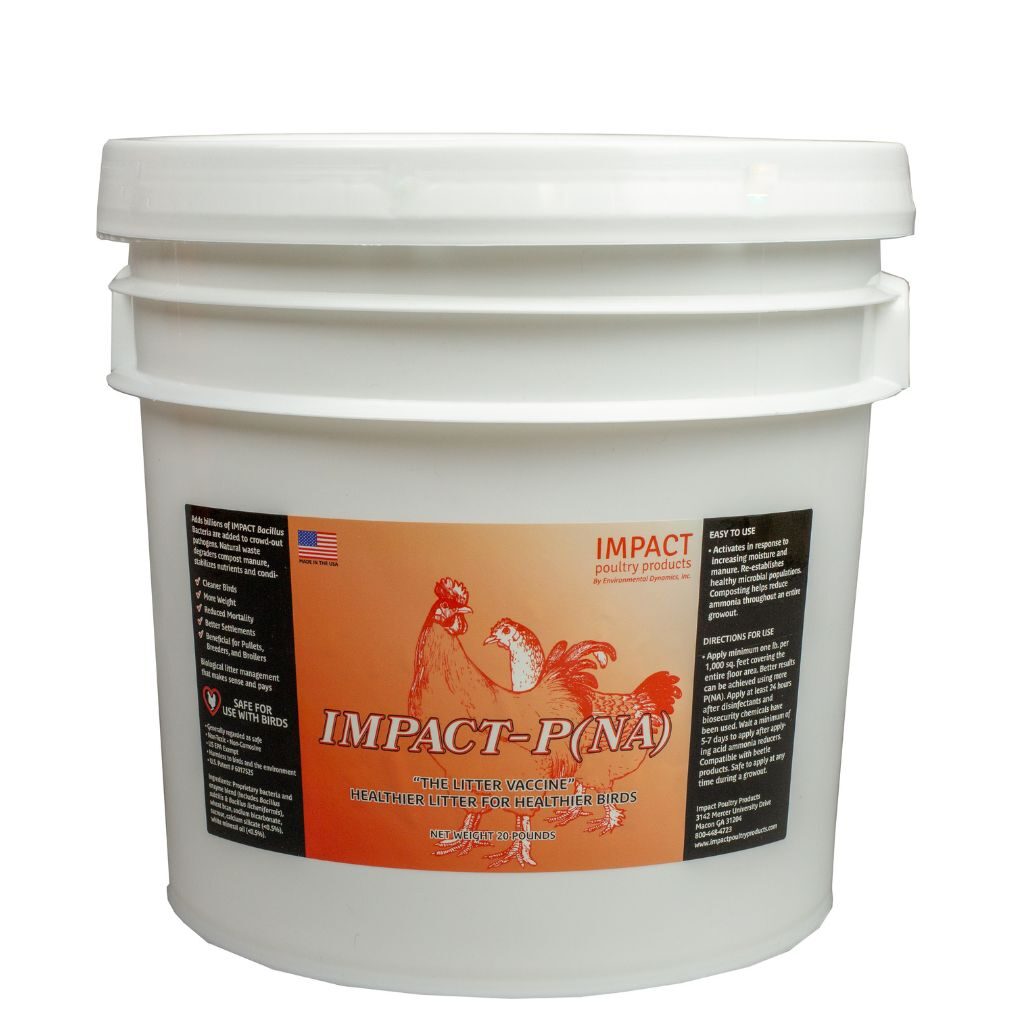IMPACT-P(NA)
Litter-Biotic

Overwhelm and Out-Compete Pathogens
Huge numbers of laboratory-grown, beneficial bacteria overwhelm and out-compete pathogens that can cause disease outbreaks in your flock.
Lower Ammonia Levels
A patented blend of bacteria and enzymes efficiently composts poultry waste resulting in lower ammonia levels and a healthier growing environment for your flock’s entire growout.
Continuously Dry, Compost, Improve the Litter
Vast numbers of highly efficient composting bacteria do what they do best … continuously dry, compost, and improve your litter with each flock.
Easy and Safe To Use
Quick and easy to apply with a seed broadcaster; non-toxic and safe to apply with birds in the house; non-corrosive; good to use within days of litter acidifiers.
Microbes matter. Don't leave your litter to chance!
IMPACT-P(NA) is a “need activated” biological litter amendment. Applied before each flock at a concentration of nearly a billion bacteria per square foot, IMPACT-P(NA) introduces huge populations of beneficial, waste-degrading Bacillus bacteria to the litter. These bacteria are “need activated” and begin growing as the moisture, heat, and nutrients increase as the flock grows. This ensures that IMPACT-P(NA) bacteria continue to help improve the litter for the flock’s entire growout.
IMPACT-P(NA) helps to tilt the litter microbiome in your favor to limit the growth of disease causing bacteria, reduce ammonia, and improve overall litter quality.
IMPACT-P(NA) bacteria outcompete harmful, fast growing, disease-causing bacteria like Salmonella, E. coli, Pasteurella, and Clostridium. All types of bacteria thrive on the nutrients, moisture, and heat in poultry litter. By regularly introducing artificially high populations of IMPACT-P(NA) bacteria before each flock, you help to ensure that the bacteria thriving in your litter are dominated by IMPACT-P(NA)’s helpful, harmless bacteria, rather than fast-growing disease-causing microbes.
IMPACT-P(NA) bacteria are highly efficient waste degraders. Not all bacteria are good at decomposing poultry waste. The less efficient the decomposition process, the higher the production of ammonia. IMPACT-P(NA)’s bacteria are specifically selected because they are highly efficient waste degraders. By conserving and stabilizing nitrogen in the litter, IMPACT-P(NA) bacteria naturally reduce ammonia levels by as much as 50% for the flock’s entire growout.
IMPACT-P(NA) bacteria continuously compost the litter in place. This composting action helps to dry out the litter and eliminate moisture that disease-causing bacteria need to grow. Naturally composting the litter in place, reducing moisture in the litter, and maintaining a healthy microbiome – dominated by beneficial bacteria – helps ensure that litter can be safely used flock after flock, saving time and money during the resting period.
IMPACT-P(NA) is easily and quickly applied as a dry product using a seed spreader or broadcaster. It is non-toxic and non-corrosive and can be safely applied onto the litter at any time, before or after birds are placed.
Directions:
Apply IMPACT-P(NA) on top of the litter after decaking, stripping, windrowing, or adding a fresh top-coat of litter. If using an acid ammonia reduction chemical, wait at least 5-7 days before applying IMPACT-P(NA) to allow the temporary acidic conditions caused by the products to wear off. The low pH resulting from the use of ammonia reduction chemicals kills bacteria and will retard the growth of IMPACT-P(NA) bacteria.
Minimum application rate is 1 lbs. / 1,000 sq. ft. of floor space (one 20 lbs. pail per 20,000 sq.ft. house).
Use a seed spreader or broadcast spreader to evenly apply the IMPACT-P(NA) by walking a horseshoe around the outside drinker lines and again around the inside of the drinker lines. This ensures whole house coverage and overlap in the feed and water areas where the highest nutrient buildups occur during growout.
IMPACT-P(NA) will not conflict with beetle products or vaccines. It is safe to apply at any time during the growout, but is most effective if applied as near the beginning of the flock as possible.